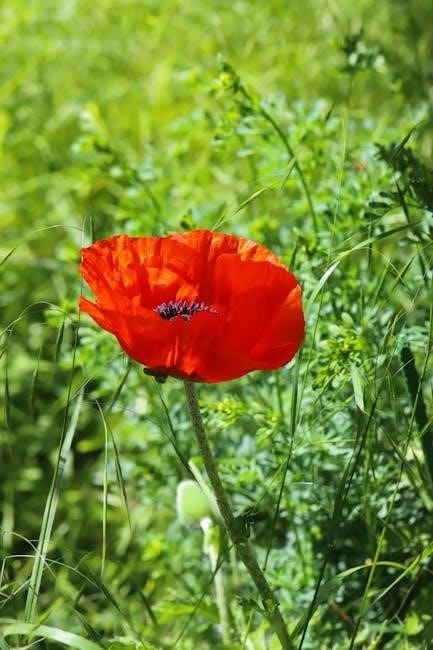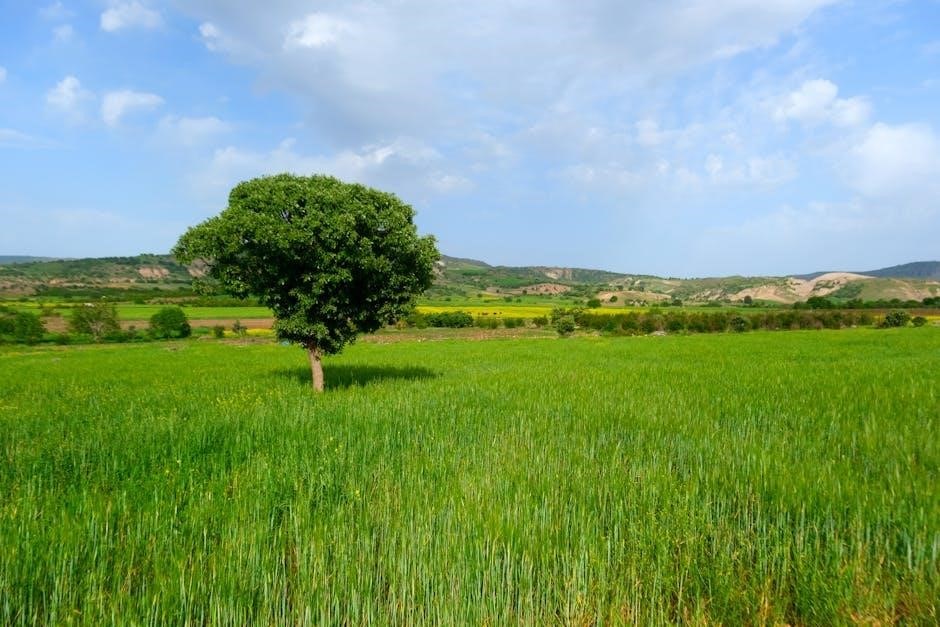earthbox growing guide
EarthBox gardening offers a self-watering, sustainable way to grow vegetables, herbs, and flowers with minimal effort. Perfect for all skill levels, it ensures water efficiency and consistent growth.
What is an EarthBox?
An EarthBox is a self-contained, sustainable container gardening system designed to simplify growing vegetables, herbs, and flowers. It features a closed-bottom container with an aeration screen and water reservoir, eliminating the need for frequent watering. The system uses a wicking process to deliver water and nutrients to plants as needed, reducing water waste. This innovative design allows plants to absorb water efficiently, promoting healthy growth. The EarthBox is ideal for patio, deck, or backyard gardening, making it accessible for beginners and experienced gardeners alike. Its compact size and self-watering mechanism ensure consistent plant growth with minimal effort and water usage.
Benefits of Using an EarthBox
Using an EarthBox offers numerous benefits for gardeners of all skill levels. The self-watering system eliminates the need for frequent watering, reducing water waste and ensuring plants receive consistent moisture; It maximizes yields with minimal effort, making it ideal for busy individuals. The EarthBox is space-efficient, perfect for small spaces like patios or decks. It also promotes healthy plant growth by delivering water and nutrients directly to the roots. This sustainable system is eco-friendly and suitable for growing a variety of vegetables, herbs, and flowers. It simplifies gardening, making it accessible for beginners while providing expert results. The EarthBox is a versatile and innovative solution for home gardening, ensuring success and enjoyment for all users.
How the EarthBox System Works
The EarthBox system operates as a self-watering, closed-loop container gardening solution. It features a container with an aeration screen, water reservoir, and fill tube. Plants are grown in potting soil above the water reservoir, which supplies moisture through a wicking action. The aeration screen prevents root rot by allowing air to reach the roots. Water is added via the fill tube, and the system delivers moisture and nutrients to the plants as needed. This design minimizes watering frequency and reduces water waste, ensuring efficient growth. The EarthBox works differently from traditional containers, with its unique features optimizing water and nutrient delivery for healthy plant development. Its innovative design simplifies gardening while promoting sustainable practices.
Setting Up Your EarthBox
Setting up your EarthBox is straightforward and efficient, requiring minimal effort. Its self-watering design ensures consistent growth, making it ideal for gardeners of all skill levels.
Materials Needed for Assembly
To assemble your EarthBox, you will need a few essential components. Start with the EarthBox container itself, which includes the aeration screen and water fill tube. Add 2 cubic feet of high-quality potting medium, ensuring it’s packed down properly. You’ll also need a bag of dolomite or starter fertilizer and another of high-analysis fertilizer for optimal plant nutrition. A plastic mulch cover is provided to retain moisture and regulate soil temperature. These materials work together to create a self-contained, efficient growing system. Proper assembly ensures the EarthBox functions as intended, delivering water and nutrients to your plants effectively. Gathering all these items beforehand will make the setup process smooth and hassle-free.
Step-by-Step Assembly Instructions
Begin by placing the aeration screen into the EarthBox container, ensuring it fits snugly at the bottom. Next, insert the water fill tube through the designated opening, aligning it with the aeration screen. Fill the container with 2 cubic feet of potting medium, packing it firmly around the tube and screen. Leave about 2 inches of space at the top. Place the dolomite or starter fertilizer in the center, followed by the high-analysis fertilizer around it. Cover the fertilizer with a thin layer of potting soil. Finally, attach the plastic mulch cover, securing it tightly to retain moisture and regulate temperature. Double-check all components to ensure proper alignment and functionality before planting.
Preparing the Soil and Fertilizer

To prepare the soil and fertilizer for your EarthBox, start by selecting a high-quality potting medium; Fill the container with 2 cubic feet of this medium, leaving about 2 inches of space at the top. Place the dolomite or starter fertilizer in the center of the container, spreading it evenly. Next, sprinkle the high-analysis fertilizer around the starter fertilizer, following the recommended dosage. Cover the fertilizers with a thin layer of potting soil to prevent direct contact with plant roots. Ensure the soil is firmly packed around the water reservoir and aeration screen to maintain proper moisture distribution. Avoid over-tightening, as this can restrict root growth and water flow. This setup ensures optimal nutrient delivery and water availability for your plants.
Plant Selection and Placement
EarthBox gardening allows optimal plant selection and placement using detailed charts. These guides ensure proper spacing and fertilizer distribution, maximizing yields for various vegetables, herbs, and flowers.
Choosing the Right Plants for Your EarthBox
Selecting the right plants for your EarthBox is essential for a successful harvest. The EarthBox system supports a wide variety of vegetables, herbs, and flowers, making it versatile for any gardener. Leafy greens like lettuce and spinach thrive in its self-watering environment, while tomatoes and peppers benefit from the consistent moisture and nutrient delivery; Herbs such as basil and mint also grow exceptionally well. The system’s design allows for optimal water and nutrient absorption, ensuring healthy plant growth. By choosing plants that are compatible with container gardening and suitable for your climate, you can enjoy a bountiful yield with minimal effort. Always refer to the EarthBox planting charts for specific recommendations tailored to your needs.
Plant and Fertilizer Placement Charts
Plant and fertilizer placement charts are essential tools for optimizing your EarthBox setup. These charts provide an aerial view of the container, illustrating the best positions for plants and fertilizer based on the number of seedlings or plants recommended per variety. They ensure proper spacing, nutrient distribution, and water accessibility, maximizing growth potential; By following these guides, you can avoid overcrowding and nutrient imbalances, leading to healthier plants and higher yields. The charts are tailored to specific plant types, offering clear instructions for placement. Whether you’re growing vegetables, herbs, or flowers, these charts help you achieve the best results. Refer to them for precise guidance on arranging your plants and fertilizers effectively in the EarthBox system.

Optimal Plant Spacing for Maximum Yields
Optimal plant spacing is crucial for maximizing yields in an EarthBox. Proper spacing prevents overcrowding, allowing plants to receive adequate sunlight, air circulation, and root growth. Overcrowding can lead to reduced yields, disease, and pest issues. Different plants have varying space requirements, so it’s important to follow specific guidelines for each variety. For example, larger plants like tomatoes may need more space, while smaller herbs or lettuce can be placed closer together. EarthBox placement charts provide detailed recommendations for spacing to ensure each plant thrives. By adhering to these guidelines, you can create a balanced and productive growing environment, ensuring your plants reach their full potential and deliver abundant harvests.

Maintenance and Care
Regular watering, fertilizing, and monitoring soil health are essential for EarthBox success. Maintain proper water levels, check soil moisture, and ensure adequate aeration for healthy plant growth.
Watering Strategies for the EarthBox System
The EarthBox system features a built-in water reservoir that supplies plants as needed, reducing the frequency of watering. This self-watering mechanism ensures consistent moisture levels in the soil, promoting healthy root development. Overwatering is prevented by the aeration screen, which allows excess water to drain while maintaining oxygen flow. For optimal results, water should be added directly to the reservoir until it reaches the recommended level. Avoid getting water on the leaves to prevent fungal diseases. During hot weather, check the reservoir more frequently to ensure it never dries out. Proper watering strategies maximize water efficiency and plant health in the EarthBox system, making it ideal for gardeners of all levels.
Fertilizing Tips for Healthy Plant Growth
Fertilizing is crucial for maximizing yields in your EarthBox. Use a high-quality potting mix enriched with organic matter to provide essential nutrients. Apply a starter fertilizer at planting time to promote strong root development. For sustained growth, incorporate a balanced, water-soluble fertilizer into the water reservoir every 1-2 weeks. Avoid over-fertilizing, as this can harm plants and reduce soil health. Place fertilizer directly beside the water fill tube to ensure even distribution through the soil. Regularly monitor plant health and adjust fertilization based on growth progress. Proper fertilization, combined with the EarthBox’s efficient watering system, ensures robust and healthy plant growth throughout the season.
Monitoring Soil Health and Aeration
Regularly monitoring soil health and aeration is essential for optimal plant growth in your EarthBox. Check the soil moisture by gently digging into the top layer; it should be damp but not waterlogged. The aeration screen in the EarthBox system prevents waterlogging and ensures proper air circulation. Ensure the water reservoir is filled adequately to maintain soil moisture without oversaturating. Avoid compacting the soil, as this can hinder root growth and reduce aeration. If necessary, gently loosen the soil with a fork to improve airflow. Healthy soil structure promotes strong root development and supports the overall vitality of your plants. By maintaining proper soil conditions, you can maximize the efficiency of the EarthBox system and enjoy a thriving garden.

Troubleshooting Common Issues
Identify and address issues like waterlogged soil, nutrient deficiencies, or pests promptly. Check the aeration screen and soil conditions to ensure optimal growing environments for your plants.
Pest and Disease Management
Regularly inspect your EarthBox for pests like aphids, whiteflies, and spider mites. Use neem oil or insecticidal soap to treat infestations early. For diseases such as powdery mildew or root rot, ensure proper air circulation and avoid overwatering. Remove infected plants or plant parts to prevent spread. Maintain soil health by replenishing nutrients and avoiding waterlogged conditions. Encourage beneficial insects like ladybugs to naturally control pests. Apply organic fungicides if necessary. Sanitize tools and containers to prevent contamination. Monitor plants daily and address issues promptly to protect your harvest and maintain a thriving EarthBox garden.
Addressing Common Growing Challenges
Common challenges in EarthBox gardening include nutrient deficiencies, overwatering, and pests. Check the water reservoir regularly to ensure it’s filled, as dry soil can stress plants. Avoid overfertilizing, as this can burn roots. If leaves yellow or wilt, inspect for pests or adjust watering. For nutrient deficiencies, follow the recommended fertilizer schedule. Ensure proper drainage and aeration to prevent root rot. If plants are leggy, provide adequate sunlight or consider growing varieties suited to your light conditions. Address issues promptly to maintain plant health and maximize yields. Monitor temperature fluctuations, as extreme heat or cold can affect growth. By addressing these challenges, you can ensure a thriving and productive EarthBox garden.
